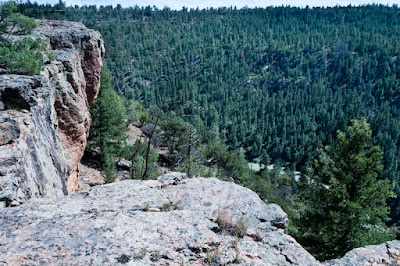First, there was "Travels To The Edge with Art Wolfe", a PBS series in which Art Wolfe, a master photographer, is accompanied by a film crew as he goes to, and photographs, marvelous places. More recently, a knock-off of this idea, "Beyond The Edge with Peter Lik" was done. Art Wolfe tells an entertaining and informative story in each half hour segment. Peter Lik shares the challenges and frustrations involved in trying to get that "gallery shot".
So, here is my version of "edgy" photography. I am at Heron Lake in New Mexico. The Rio Chama flows out of the dam that forms the reservoir, into a canyon 430 feet below the rim that is perhaps a half mile south of where I am sitting at this moment. I hiked to that edge yesterday.
Approaching the edge, it is a very sharp lip of hard, tight rock, tilting slightly away from the chasm.
Some great views are available of the river below and the canyon formed by it.
The area near the edge is decorated with vegetation, including wildflowers.
Looking carefully (and when you go, alone, to such places you ALWAYS need to look carefully) that solid, tight edge looks a little less secure. First, it tends to be undercut, so the rock right at the edge is resting on air.
What is really unsettling is that there are often fissures near the edge.
These fissures are being enlarged by moisture that penetrates the cracks, filling them with ice in the winter. The ice expands and pushes the crack open a tiny bit more each year. In places, these fissures can be all but invisible, marked only by a line of vegetation whose roots find moisture below the rock surface that underlies a thin film of dirt.
Some are easy to spot.
Others are harder.
With some, a faint crack here and there in the rock, and a line of trees, may be your only warning. Instinct is your friend (and no, they do not come with nice, neat red dashed lines marking them)
In places they can be deep, pronounced and unmistakeable.
Here is what it looks like BELOW that fissure.
I tried to be sure that I did not walk on the edge side of any fissures, whether subtle or obvious. In geological terms, these overhangs are about to drop into the canyon. Maybe it will happen in 10,000 years, or 100 years, or maybe tomorrow. All I know is I do not want to be standing on the edge when it decides it is time to drop.
So - why go to such places? For the view, of course.
Even the walk back on the flats can be nice.























































